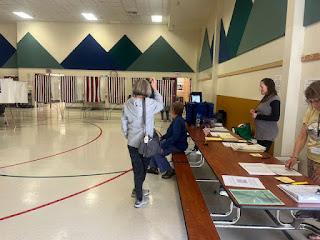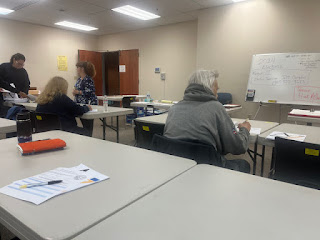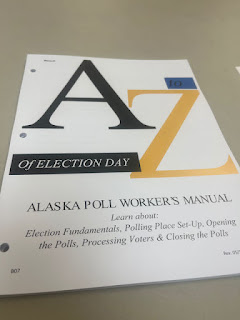Let's see if I can write a quick, short post.
1. The Alaska Supreme Court approved a lower court ruling putting a ballot measure to repeal Ranked Choice Voting after there were a number of challenges to how the group operated. I didn't read the court case [I went back and looked and it's very short and says,
"An opinion explaining this decision will be issued at a later date."
but the Anchorage Daily News reported today that a) they have traditionally decided in favor of putting measures on the ballot and b) the technical issue (a notary's license had expired) wasn't the fault of the petitioners and so getting a signature booklet notarized again, after the deadline, was acceptable. There were other irregularities for which the petitioners got a hefty fine (like hiding funding sources by forming a 'church' in Washington State) but in the end, it will be on the ballot.
2. The anti ranked choice voting push is coming from the die-hard Republicans of Alaska. They keep talking about it hurting them. In one sense, they are right. The change to ranked choice voting includes getting rid of closed primaries. In closed primaries the more extreme and partisan Republican candidates tend to get elected. Open primaries combined with ranked choice voting dilutes the partisanship because more than die-hard Republicans vote in the open primary. But, ranked choice voting means that if there are several people from the same party in the final four from the primary, they don't have to split the vote and lose to a Democrat. They just have to it cooperate and get Republicans to rank other Republican candidates second and even third. If they only vote for one candidate, they aren't helping the party to get the most out of ranked choice voting.
But they can't quite seem to take advantage of it. Last time round (2022, the first time we used ranked choice voting) lots of voters chose one of the two top Republicans first and then either did not rank anyone else or chose the Democratic candidate.
3. Today, we also learned that Republican candidate Nancy Dahlstrom, who came in third behind Democratic incumbent Mary Peltola and Republican challenger Nick Begich III, dropped out of the race. Begich had pledged to drop out if he wasn't the top GOP candidate, but Dahlstrom hadn't made such a pledge. But she got A LOT of comments on Twitter yesterday telling her to drop out. Will it matter? She could have just told her voters to vote for Begich as their second choice.
Rather than take advantage of ranked choice voting by cooperating on ranking, they've pushed Dahlstrom out altogether.
4. But the Democratic incumbent got just over 50% of the initial primary vote. The turnout was very low. Only 16% of voters participated. This does not count the people who voted by mail though, and the numbers will go up somewhat and that 50% might change. But that's a formidable lead. And there were 12 total candidates. If a candidate drops out, the next highest candidate moves up to the fourth spot on the ballot.
Also, this primary was not a high interest election. Voters had only the Congressional race, which with ranked choice voting, wasn't going to eliminate the top Democratic or Republican choices, plus a state house race in each district. And one third of the districts had Senate races. [It's supposed to be 1/3 of the senate get voted on each election, but right after redistricting, the first election may have more. (I just went back and checked - there were ten senate races, which is 1/2 of the senators.)]
Unfortunately, I suspect most voters don't really know much about their state house and senate candidates. I was surprised Tuesday at how long some people spent in the voting booths to vote for three races. (I was a poll worker so I could see that.)
But I think there will be a lot more interest when the presidential candidates are on the ballot in November. The US House race will essentially be a two person race. Dahlstrom, the third place candidate had 20% of the vote. The fourth place candidate, Matt Salisbury, had .60% (that's less than one per cent) as of the Tuesday night tally. With Dahlstrom dropping out, there will be room for the next highest vote getter, John Wayne Howe, the Alaska Independent Party candidate who got .57% of the vote.
I suspect a lot of voters who absolutely don't want Trump will put Peltola (the Democrat) first or second, but will skip the strongly anti-abortion Begich as a second choice.
5. Ranked choice voting was approved in 2020 by a slim majority by voters. But I think Alaskans got to see how easy and sensible it was in 2022 (I was a poll worker and got to hear from voters as they brought their filled out ballots to the voting machine). I did have one voter on Tuesday (I worked at the polls again in the primary) who was vehemently opposed to ranked choice voting. "It's unconstitutional. It's one man one vote, not four votes." But I'm guessing he doesn't represent most Alaskan voters, who, I believe will endorse it more strongly this time.
Also, the national organizations supporting ranked choice voting are putting a fair amount of money up to make sure it stays in Alaska. (See the ADN article linked above)




















